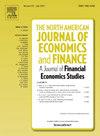Dynamic q-dependent cross-correlation test for investment classification and its application on green finance
IF 3.9
3区 经济学
Q1 BUSINESS, FINANCE
North American Journal of Economics and Finance
Pub Date : 2025-09-02
DOI:10.1016/j.najef.2025.102535
引用次数: 0
Abstract
This study develops a novel methodological framework, the dynamic -dependent cross-correlation (DQCC) test, to evaluate the diversification, hedging, and safe-haven properties of financial assets under conditions of fractality and nonlinear dependence. Traditional econometric approaches often fail to capture three critical aspects of financial markets: time-varying structures, heterogeneous investment horizons, and fluctuation-dependent dynamics. To address these limitations, the proposed framework integrates fractal theory and econophysics-based cross-correlation measures, enabling a simultaneous analysis of time, scale, and moment dimensions. Empirically, the model is applied to the nexus between green bonds and equity markets. Methodologically, both quantile-based and event-based specifications are employed to assess asset behavior under normal conditions and during systemic crises, including the COVID-19 pandemic, the Russia–Ukraine war, and the Hamas–Israel conflict. The results reveal strong evidence of multifractality and nonlinear dynamics across all return series, rejecting market efficiency. Green bonds are found to provide persistent diversification benefits against both advanced and emerging market equities under ordinary conditions, while their safe-haven properties emerge during extreme downturns, particularly at lower quantiles and longer horizons. Event-based results confirm the safe-haven role of green bonds during COVID-19, with more mixed evidence during geopolitical crises. No robust hedging capacity is observed. The study contributes to the literature by introducing a comprehensive testing framework for investment classification under fractal dynamics and by extending the understanding of the green bond–equity nexus across advanced and emerging markets. The findings carry significant implications for portfolio construction, risk management, and sustainable finance, and the model can be applied to other asset classes to evaluate their potential roles as diversifiers, hedges, or safe-haven.
投资分类的动态q相关检验及其在绿色金融中的应用
本研究开发了一种新的方法框架,即动态q相关互相关(DQCC)检验,以评估分形和非线性依赖条件下金融资产的多样化、套期保值和避险特性。传统的计量经济学方法往往无法捕捉到金融市场的三个关键方面:时变结构、异质投资视野和依赖波动的动态。为了解决这些限制,提出的框架集成了分形理论和基于经济物理学的相互关联度量,能够同时分析时间、尺度和力矩维度。实证研究表明,该模型适用于绿色债券与股票市场之间的关系。在方法上,采用基于分位数和基于事件的规范来评估正常情况下和系统性危机期间的资产行为,包括COVID-19大流行、俄罗斯-乌克兰战争和哈马斯-以色列冲突。结果揭示了多重分形和非线性动力学在所有收益序列的有力证据,拒绝市场效率。研究发现,在一般情况下,绿色债券对发达市场和新兴市场股票都能提供持续的多元化收益,而在极端低迷时期,尤其是在较低的分位数和较长的时间跨度时,绿色债券的避险属性会显现出来。基于事件的结果证实了绿色债券在2019冠状病毒病期间的避险作用,在地缘政治危机期间的证据则更为复杂。没有观察到稳健的对冲能力。本研究通过引入分形动态下投资分类的综合测试框架,并通过扩展对发达市场和新兴市场绿色债券-股票关系的理解,为文献做出了贡献。研究结果对投资组合构建、风险管理和可持续金融具有重要意义,该模型可应用于其他资产类别,以评估其作为多元化、对冲或避险的潜在作用。
本文章由计算机程序翻译,如有差异,请以英文原文为准。
求助全文
约1分钟内获得全文
求助全文
来源期刊
CiteScore
7.30
自引率
8.30%
发文量
168
期刊介绍:
The focus of the North-American Journal of Economics and Finance is on the economics of integration of goods, services, financial markets, at both regional and global levels with the role of economic policy in that process playing an important role. Both theoretical and empirical papers are welcome. Empirical and policy-related papers that rely on data and the experiences of countries outside North America are also welcome. Papers should offer concrete lessons about the ongoing process of globalization, or policy implications about how governments, domestic or international institutions, can improve the coordination of their activities. Empirical analysis should be capable of replication. Authors of accepted papers will be encouraged to supply data and computer programs.

 求助内容:
求助内容: 应助结果提醒方式:
应助结果提醒方式:


